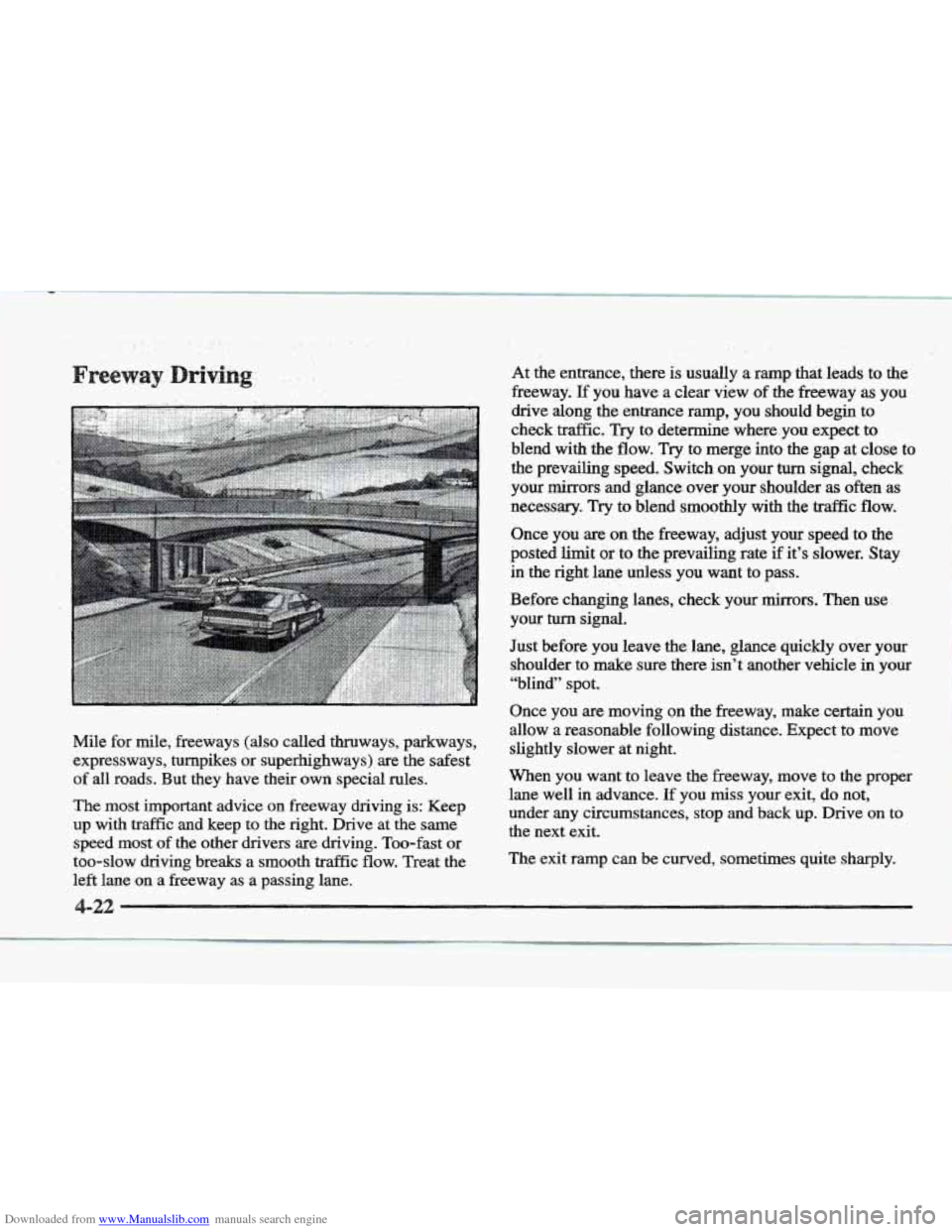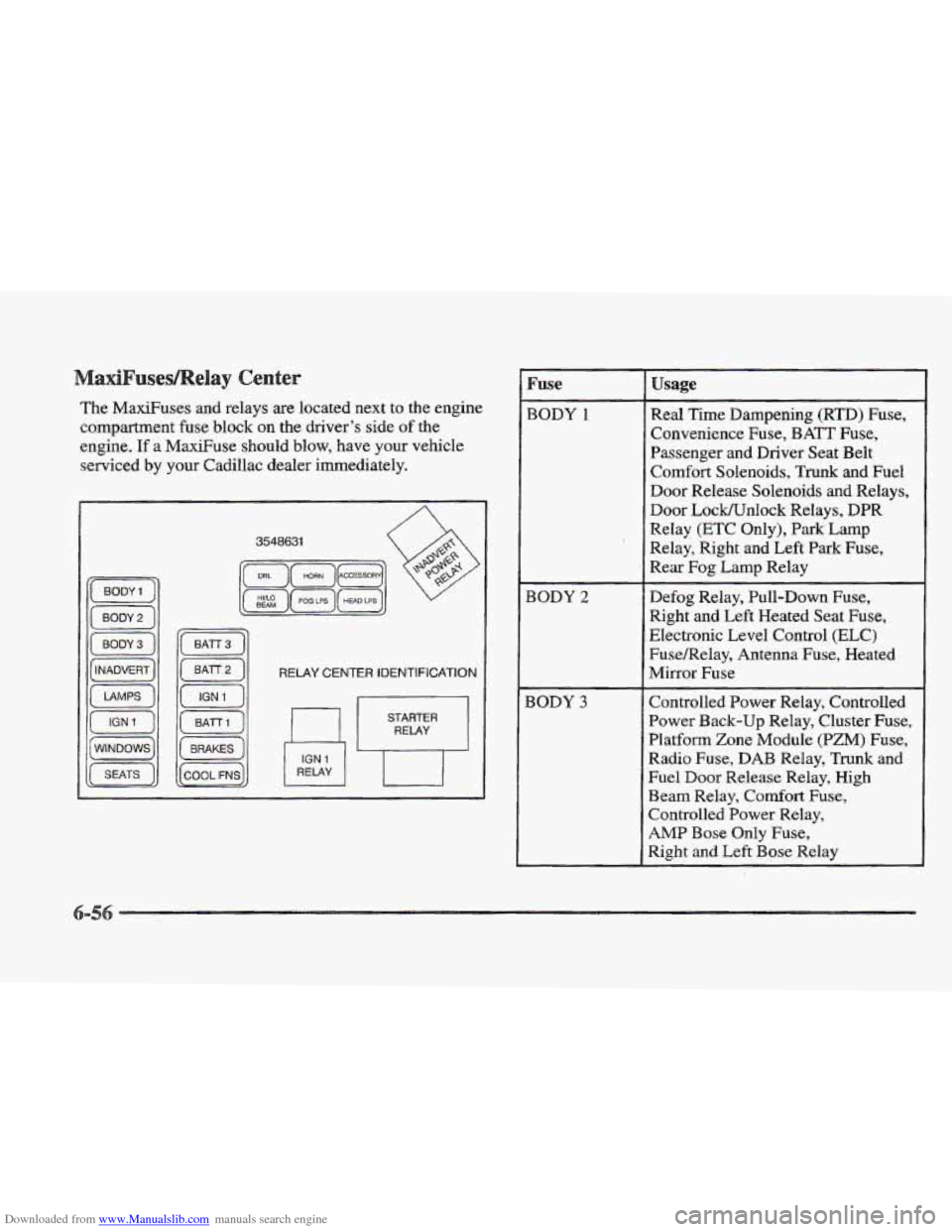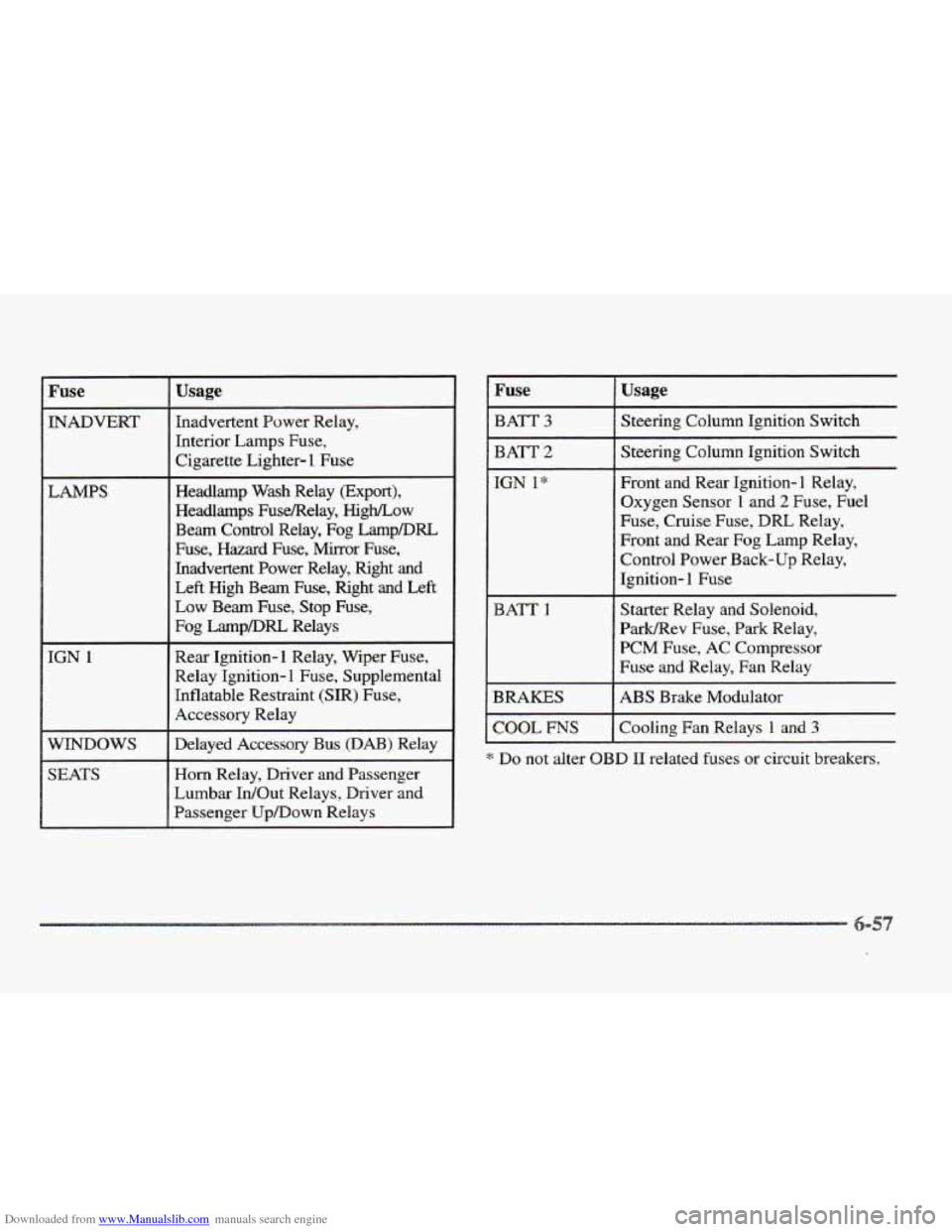Page 207 of 361

Downloaded from www.Manualslib.com manuals search engine Mile for mile, freeways (also called thruways, parkways,
expressways, turnpikes or superhighways) are the safest
of all roads. But they have their own special rules.
The most important advice on freeway driving is: Keep
up with traffic and keep to the right. Drive at the same
speed most
of the other drivers are driving. Too-fast or
too-slow driving breaks a
smooth traffic flow. Treat the
left lane
on a freeway as a passing lane. At
the entrance, there is usually a ramp that leads to the
freeway. If you have a clear view of the freeway as you
drive along the entrance ramp, you should begin to
check trafl5c.
Try to determine where. you expect to
blend with the
flow. Try to ,merge into the gap at close to
the prevailing speed. Switch on your turn Signal, check-
your mirrors and,glance..over
your shoulder as often as
necessary. Try to blend'smoothly with the traffic flow.
Once
you are on the freeway, adjust your speed to the
posted limit or to the prevailing rate if it's
slower. Stay
in the right lane unless you want to pass.
Before changing lanes, check your mirrors. Then use
your
turn signal.
Just before you leave the. lane, glance quickly over your
shoulder to make sure there isn't another vehicle in your
"blind" spot.
Once you
are moving on the freeway, make certain you
allow a reasonable following distance. Expect to move
slightly slower at night.
When you want to leave the freeway, move to the proper
lane well in advance. If you
miss your exit, do not,
under any circumstances, stop and back up. Drive
on to
the next exit.
The exit ramp can be curved, sometimes quite sharply.
Page 209 of 361

Downloaded from www.Manualslib.com manuals search engine Is there actually such a condition as “highway hypnosis”?
Or is it just plain
falling asleep at the wheel? Call it
highway hypnosis, lack
of awareness, or whatever.
There is something.about
an easy stretch of road with
the same scenery, along with the hum of the tires on the
road, the drone
of the engine, and the rush of the wind
against
the vehicle that can make you sleepy. Don’t let it
happen to you!
If it does, your vehicle .can leave the
road
in less than a second, and you could crash and
be injured.
What can you
do about highway hypnosis? First, be
aware that it can happen.
Then here
are some tips:
e
e
Make sure your vehicle is well ventilated, with a
comfortably cool interior.
Keep your eyes moving. Scan the road ahead
and to
the sides. Check your rearview mirrors
and your
instruments frequently.
If you get sleepy, pull off the road into a rest, service
or parking area
and take a nap, get some exercise, or
both. For safety, treat drowsiness on the highway as
an emergency. Driving on steep hills or mountains is different from
driving
in flat or rolling terrain.
Page 221 of 361

Downloaded from www.Manualslib.com manuals search engine You should always attach chains between your vehicle
and your trailer. Cross the safety chains under the tongue
of the trailer
so that the tongue will not drop to the road
if it becomes separated from the
hitch. Instructions
about safety chains may be provided by the hitch
manufacturer or by
the trailer manufacturer. Follow the
manufacturer’s recommendation
for attaching safety
chains and do
not attach them to the bumper. Always
leave just enough slack
so you can turn with your rig.
And, never allow safety chains to drag
on the ground.
Because you have anti-lock brakes, don’t
try to tap into
your vehicle’s hydraulic brake system.
If you do, both
brake systems won’t work well, or at all.
Be
sure to read and follow the instructions for the trailer
brakes
so you’ll be able to install, adjust and maintain
them properly.
Towing a trailer requires a certain amount
of experience.
Before setting out for
the open road, you’ll want to get
to know your
rig. Acquaint yourself with the feel of
handling and braking with the added weight of the trailer. And always
keep
in mind that the vehicle you are
driving is now a good deal longer and not nearly as
responsive
as your vehicle is by itself.
Before you start, check the trailer hitch and platform
(and attachments), safety chains, electrical connector,
lamps, tires and mirror adjustment.
If the trailer has
electric brakes, start your vehicle and trailer moving
and
then apply the trailer brake controller by hand to be sure
the brakes are working. This lets you check your
electrical connection at the same time.
During your trip, check occasionally to be sure that
the
load is secure, and that the lamps and any trailer brakes
are still working.
Stay at least twice as far behind the vehicle ahead as you
would when driving your vehicle without a trailer. This
can help you avoid situations that require heavy braking
and sudden turns.
You’ll need more passing distance
up ahead when
you’re towing
a trailer. And, because you’re a good deal
longer, you’ll need to
go much farther beyond the
passed vehicle before you can return to your lane.
Page 319 of 361

Downloaded from www.Manualslib.com manuals search engine The MaxiFuses and relays are located next to the engine
compartment fuse block
on the driver’s side of the
engine. If a MaxiFuse should blow, have your vehicle
serviced by your Cadillac dealer immediately.
3548631
RELAY CENTER IDENTIFICATION
,r\E
RELAY
Fuse
BODY 1
BODY 2
BODY 3
usage
Real Time Dampening (RTD) Fuse,
Convenience Fuse, BATT Fuse,
Passenger and Driver Seat Belt
Comfort Solenoids, Trunk and Fuel
Door Release Solenoids and Relays,
Door LocWnlock Relays, DPR
Relay
(ETC Only), Park Lamp
Relay, Right and Left Park Fuse,
Rear Fog Lamp Relay
Defog Relay, Pull-Down Fuse,
Right and Left Heated Seat Fuse,
Electronic Level Control
(ELC)
FuseRelay, Antenna Fuse, Heated
Mirror Fuse
Controlled Bower Relay, Controlled
Power Back-up Relay, Cluster Fuse,
Platform Zone Module (PZM) Fuse,
Radio Fuse,
DAB Relay, Trunk and
Fuel
Door Release Relay, High
Beam Relay,
C0mf01-t Fuse,
Controlled Power Relay,
AMP Bose Qnly Fuse,
Right
and Left Bose Relay
Page 320 of 361

Downloaded from www.Manualslib.com manuals search engine Fuse
INADVERT
LAMPS
____~
IGN 1
WINDOWS
SEATS
Usage
Inadvertent Power Relay,
Interior Lamps
Fuse,
Cigarette Lighter- 1 Fuse
Headlamp Wash Relay (Export),
Headlamps FuseRelay,
High/Low
Beam Control Relay, Fog LampDRL
Fuse, Hazard Fuse, Mirror Fuse,
Inadvertent Power Relay, Right
and
Left High Beam Fuse, Right and Left
Low Beam Fuse, Stop Fuse,
Fog LampDRL Relays
Rear Ignition-1 Relay, Wiper Fuse,
Relay Ignition-
1 Fuse, Supplemental
Inflatable Restraint (SIR) Fuse,
Accessory Relay
Delayed Accessory Bus
(DAB) Relay
Horn Relay, Driver and Passenger
Lumbar IdOut Relays, Driver and
Passenger Up/Down Relays
I Fuse
I BATT 3
I BATT 2
I COOL ms
Usage
Steering Column Ignition Switch
Steering Column Ignition Switch
Front and Rear Ignition- 1 Relay,
Oxygen Sensor
1 and 2 Fuse, Fuel
Fuse, Cruise
Fuse, DRL Relay,
Front and
Rear Fog Lamp Relay,
Control Power Back-up Relay,
Ignition-
1 Fuse
Starter Relay and Solenoid,
Park/Rev Fuse,
Park Relay,
PCM Fuse,
AC Compressor
Fuse and Relay, Fan Relay
ABS Brake Modulator
Cooling Fan Relays
1 and 3
* Do not alter OBD I1 related fuses or circuit breakers.
Page 322 of 361
Downloaded from www.Manualslib.com manuals search engine (irilIunn]
COR LPS INT LPS CIG LTR1 CIG LTRP
Innnnnl
L HDLP LO R HDLP LO L HDLP HI R HDLP HI
I , HDLPS I I HAZARD I I STOP I I MIRROR I I DRL , I
I , IGN O(ENG) , I , I ABS I I IGN 1 I I WIPERS , I
FUSE CENTER IDENTIFICATION
000
A/C COMP PCM(BAT) PRK/REV
A/C COMP
I I Daytime Running Lamps I
I CQRLPS
Cornering Lamp Switch, Right
and Left Cornering
Lamps I
Fuse
INT LPS
CIG LTR1
CIG La2
L HDLP LO
W HDLP LO
L HDLP HI
R HDLP HI
FOG
mLPs
Usage
Trunk Lamp, Courtesy Lamps,
Front Vanity Lamps, Glove Box
Lamp, Garage Door Opener,
Courtesy
Lamp Relay
Front and Rear Cigarette Lighters
(Full Console Only)
Right and Left Rear Cigarette
Lighters
Left Low-Beam Meadlamp
Right Low-Beam Weadlamp
Left High-Beam Headlamp
Right High-Beam Headlamp
Right and Left Front
Fog Lamp
Relay
Meadlamp Relay, High/Low Beam
Control Relay, Right and Left
Low/High Beam
Fuses
Page 323 of 361
Downloaded from www.Manualslib.com manuals search engine Fuse
HAZARD
STOP
MIRROR
DIU
Usage
Electronic Flasher Module,
TumEIazard Switch, Right
and Left Front Turn Lamps,
Right
and Left Rear Turn Lamps,
Right and Left Repeater
Lamps
(Export), Cluster
Stoplarnp Switch, Centered
High-Mounted Stoplanlp
(CHMSL),
Turn Hazard Switch,
ABS Controller, Stepper Motor
Cruise Control, Right and Left
Rear Stoplamps (Export)
Inadvertent Power Relay, Left
Outside Rearview Mirror Switch,
ALDL, Memory Mirror Module
Dimmer Switch, Cluster
Daytime Running Lamps
(Dm)
Relay, Left and Right Low Beam
in
DRL Mode, DIU Switch
IGN 0 (ENG)*
ABS
IGN- 1
WIPERS
A/C COMP
A/C COMP
PCM (BAT)*
Usage
Powertrain Control Module (PCM)
Anti-Lock
Brake System
(ABS)/Traction Control System
Rear Ignition-1 Relay, Front
and
Rear Fog Lamp Relays, Control
Power Back-up,
DRL Relay
Accessory Relay, Wiper Switch
AC Compressor Relay, Cooling
Fan Relays 1,2, 3, Compressor
Clutch
AC Compressor
BCM
Page 324 of 361
Downloaded from www.Manualslib.com manuals search engine Fuse
PRWREV
ECS*
PCM
(IGN)*
CRUISE
Usage
TCC and Exterior Travel Brake
Switch, Reverse Relay, Right
and
Left Back-up Lamps,
Electrochromatic Mirror
(in
Header), Park Relay, Brake
Transaxle-Shift Interlock
(BTSI)
Switch, BTSI, PZM
Transaxle Shift Solenoids, Mass
Airflow, Canister Purge, PCM,
Linear Exhaust Gas Recirculation
(EGW), Front Ignition- 1 Relay
Torque Converter
Powertrain Control Module (PCM)
Electronic Ignition Control Module
Stepper Motor Cruise Control,
Power Steering Pressure Switch,
Low Refrigerant Pressure Cutoff
Switch,
Park Relay
* Do not alter OBD II related fuses or circuit breakers.